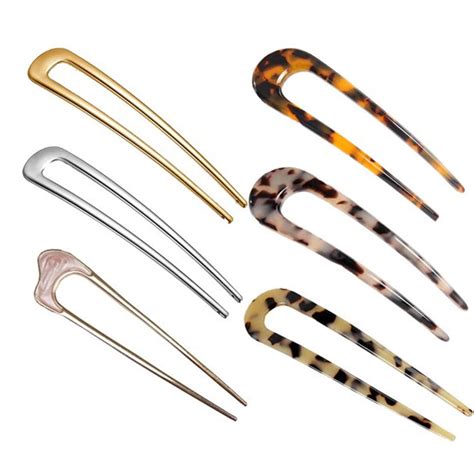French hair pins, renowned for their chic and practical versatility, have been an indispensable part of hairstyling for centuries. From intricate updos to effortless everyday styles, these versatile tools offer endless possibilities for enhancing your locks.

History and Cultural Significance
The origins of French hair pins can be traced back to ancient Greece, where women used simple sticks or pins to secure their hair. The modern French hair pin, however, emerged in France during the 19th century. Parisian fashionistas embraced these pins as both a functional and decorative accessory, inspiring a surge in their popularity.
Over the years, French hair pins have been used by countless women, including iconic figures such as Audrey Hepburn and Grace Kelly. Today, they remain a staple of hairstyling kits worldwide, offering a timeless and sophisticated touch to any hairdo.
Types of French Hair Pins
French hair pins come in a wide range of styles, each designed for a specific purpose. Some of the most common types include:
U-Pins: These classic pins resemble a “U” shape and are suitable for securing updos and braids.
Bobby Pins: Bobby pins are smaller, narrow pins that can be used to pin back loose hair, hold hair in place while styling, or create intricate hair designs.
Barrettes: Barrettes are decorative pins with a central hinge that can be used to hold back larger sections of hair or embellish hairstyles.
Hair Sticks: Hair sticks are long, slender pins that can be used to create elegant buns, chignons, and other updos.
Claw Clips: Claw clips are large, spring-loaded clips that can be used to hold hair in place quickly and easily.
Benefits of French Hair Pins
French hair pins offer numerous benefits for hairstyling:
- Versatility: French hair pins can be used to create a wide range of hairstyles, from sleek buns to intricate braids.
- Secure hold: The unique design of French hair pins ensures a secure hold without damaging hair.
- Effortless styling: French hair pins are incredibly easy to use, making them a great choice for quick and effortless styling.
- Fashionable: French hair pins add a touch of chic and sophistication to any hairstyle.
- Affordable: French hair pins are readily available and affordable, making them accessible to women of all budgets.
Innovative Applications
Beyond their traditional uses, French hair pins can also be creatively repurposed for other applications:
- As plant supports: French hair pins can be used as delicate supports for trailing plants or vines.
- For hanging jewelry: Bobby pins can be used to hang earrings, necklaces, and other jewelry from display boards or walls.
- In craft projects: French hair pins can be incorporated into craft projects to create decorative embellishments or functional items.
Tips and Tricks for Using French Hair Pins
- Choose the right type of pin: Select the appropriate type of French hair pin based on your hair type and the desired style.
- Secure the pins properly: Insert the pin into the hair at a 45-degree angle and push it through the other side of the hair.
- Use enough pins: Don’t be afraid to use multiple pins to ensure a secure hold.
- Experiment with different placements: Experiment with different placements of the pins to create unique and flattering hairstyles.
- Consider hair texture: Hair texture influences the type and number of pins needed. Thicker hair may require more pins or larger pins, while thinner hair may benefit from smaller pins.
Common Mistakes to Avoid
- Using too few pins: Too few pins can lead to insecure hold and hair falling out of place.
- Inserting the pins at the wrong angle: Inserting the pins at the wrong angle can damage hair or cause discomfort.
- Not securing the pins properly: Improperly secured pins can slip out and ruin your hairstyle.
- Using bobby pins on thick hair: Bobby pins are not suitable for thick hair, as they may not hold the hair securely.
- Storing hair pins incorrectly: Storing hair pins in damp or cluttered areas can lead to rust or damage.
FAQs
1. What is the best type of French hair pin for fine hair?
U-pins or small bobby pins are suitable for fine hair, as they provide a secure hold without weighing the hair down.
2. How many French hair pins do I need to secure a bun?
The number of pins needed depends on the size and thickness of your hair, but a minimum of 6-8 pins is recommended for a secure hold.
3. Can I use French hair pins to style short hair?
Yes, French hair pins can be used on short hair to create small buns, twists, or other embellishments.
4. How do I remove French hair pins without damaging my hair?
Gently pull the pin straight out of the hair, avoiding tugging or pulling at the hair shaft.
5. Can French hair pins be worn in water?
While some French hair pins are water-resistant, it is not recommended to wear them in water for extended periods or while swimming, as this can lead to rust.
6. How do I store French hair pins properly?
Store French hair pins in a dry, cool place, such as a vanity drawer or organizer. Avoid exposure to moisture or extreme temperatures.
Conclusion
French hair pins are versatile, stylish, and affordable accessories that can enhance any hairstyle. Embrace the endless possibilities they
